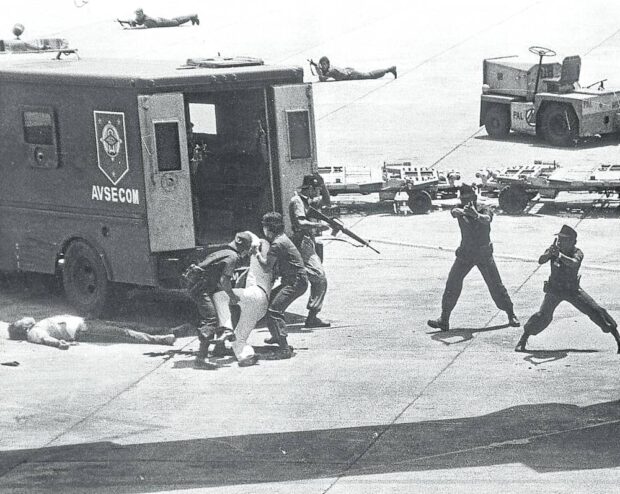
THAT SUNDAY AFTERNOON | Ninoy Aquino’s body is hoisted by airport security personnel who had escorted him upon his arrival in Manila on Aug. 21, 1983. They would later be charged with his murder. (File photo by RECTO MERCENE)
MANILA, Philippines — For many people who had lived through the last years of the dictatorship of Ferdinand Marcos Sr., the 1983 assassination of opposition leader Benigno “Ninoy” Aquino Jr. had been their political awakening.
But for his grandson Kiko Aquino Dee, who was born eight years after Aquino’s death, he only got to know his “Lolo Ninoy” through the stories of his “Lola Cory” — Aquino’s widow Corazon, who succeeded Marcos, riding on the wave of the People Power Revolution.
“Lola Cory,” he said, never put Aquino on a pedestal.
“He was a real person — someone who bought cat food even though they only owned dogs, someone who would drive his daughters to the movies or NBA games like any ordinary father,” Dee told the Inquirer.
“They [Ninoy and Cory] were simply real people who loved their country very much.”
So it was shocking for him to see public opinion shift against their family in ways “that was discordant with the way I know them,” he said. “Now not a lot of people know much about them, or if they do, they have picked up so many falsehoods and lies on social media.”
This is why he and fellow younger Aquinos have risen to the challenge of preserving the older Aquino’s legacy and memory.
‘Strange time’
As the country marks on Monday the 40th death anniversary of Aquino’s murder, his descendants continue to find allies in groups — mostly led by martial law survivors and youth activists — who share their cause in fighting historical revisionism.
“It’s a very strange time to be marking his 40th death anniversary amid all of the distortions on social media,” Dee said. “[But] we are surprised and grateful that many Filipinos continue to commemorate him.”
After all, this is the second year that the Philippines marks Ninoy Aquino Day — enshrined under Republic Act No. 9256 — under President Ferdinand Marcos Jr.
Groups like the August Twenty-One Movement, People Power Volunteers for Reform, Bayan, and Project Gunita will visit Aquino’s grave at Manila Memorial Park in the morning as well as the commemorative marker at Terminal 1 of Ninoy Aquino International Airport.
They will then go to the Sto. Domingo Church in Quezon City, where the Aquino family will lead a commemorative Mass.
‘World seems to have turned’
But as in 2022, Malacañang remained mum on the holiday, while lawmakers sympathetic to the Marcos administration were then lobbying to erase the Aquinos from the P500 bill and to have Naia renamed (this proposal, in particular, by one Arnolfo Teves Jr.).
“Sadly, if you ask Filipinos, many of them might say they only know Ninoy from these things,” said his nephew and former Sen. Bam Aquino during a recent forum. “It’s true that his memory ‘lives’ on in some ways and that will never be erased, but the way that Filipinos know him has changed dramatically.”
Echoed progressive leader and lawyer Luke Espiritu, who considered Aquino as his “idol”: “When I was young, the entire world seemed to be pro-Ninoy and anti-Marcos. After all, you can’t argue with martyrdom.”
“But now, the world seems to have turned on its axis: dictators are made heroes, while martyrs are made into villains,” he lamented.
Much of this was because of disinformation and fake news on social media, said Karl Suyat, cofounder of Project Gunita, a mostly youth-led group that sought to archive martial law-era documents.
Apart from efforts to whitewash martial law atrocities, for example, disinformation actors are also casting Aquino “as a terrorist, a communist, and a traitor,” said Suyat. “And many of these efforts to distort history are hoping to target the youth, so that Aquino’s legacy can be erased slowly.”
But this is “exactly why the youth must lead the charge in preserving not just Aquino’s memory but of the entire 20-year struggle against the dictatorship,” Suyat said.
‘Exhorting the youth’
In fact, Aquino himself believed in the power of young Filipinos in the democratic struggle, Suyat noted. In many speeches, the late senator often called on the youth to exercise their right to dissent and to fight for their freedoms.
“If in the past, Ninoy was the one exhorting the youth to stand up, now is the time [for] young people who were not yet alive to fight and defend his memory and that of the antidictatorship heroes and martyrs,” he added.
It’s a challenge that Dee, who is now deputy executive director of the Ninoy and Cory Foundation, hopes to do justice by.
Among others, he said, they are hoping to find “the right way to tell Lolo Ninoy’s memory in this environment where his story is heavily contested” — whether it’s by organizing activities and lectures about his life, or by digitizing and preserving his speeches through artificial intelligence.
He and his cousins also promised not to run for public office “so that we are never constrained by the three-year timeframe of elections… we will always have the time for the task.”
“It’s a role that I am still continuing to study and appreciate because of social media and technology,” he said. “Whatever it is, I want to find my own way of contributing to that struggle for a meaningful type of democracy.”